These days, digital marketing is more competitive than ever, especially for local service businesses. In such a cutthroat market, achieving a high conversion rate on your landing pages can be the difference between thriving and merely surviving. A fully optimized landing page not only helps in maximizing your ad spend, but also ensures that you are effectively moving visitors through the purchase process, by converting them into leads and customers.
In this blog post, we’ll walk you through actionable strategies that can help local service businesses triple their landing page’s conversion rate overnight. We’ll focus on practical examples and real-world insights that have been proven to help local service businesses increase conversion rates.
Prefer video? Check out our YouTube video on how to triple your Google Ads leads overnight here:
Still with us? Good. Let’s dive in:
Why Does Conversion Rate Optimization Matter?
Before diving into the how-to, it’s crucial to understand why conversion rate optimization (CRO) is vital for your local service business’s success. With local service businesses, it’s important to bear in mind that they usually operate in a restricted area, where the competition is high (as is the cost per click (CPC)), and they typically have poorly optimized landing pages. The end result is that they often struggle to get traction with Google Ads.

Conversion rate optimization (CRO) is not just about making changes to your landing page; it’s about making informed adjustments that drive better results, more customers, and higher profitability.
The Impact of Landing Page Conversion Rate on Your Bottom Line
Consider this: You’re offering a service priced at $10,000, with a 50% margin, meaning you make $5,000 after covering all of your costs. You’re spending $20 per click on your Google Ads campaign, which is common for competitive local service markets. With a 2% conversion rate (which is the average conversion rate we’ve seen across many local service businesses), you’re converting just 1 in 50 clicks into a lead, which translates to a cost per lead (CPL) of $1,000. If you’re spending $10,000 on ads, you’re actually losing $5,000 because your cost per lead is too high.
That’s not great.
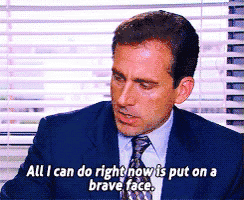
But what happens when you optimize your landing page to improve the conversion rate? Even a modest increase can make a significant difference. For instance, if you increase conversion rates from 10% to 15%, and your page conversion rate from 2% to 3%, your cost per lead drops, and your campaign becomes profitable. If you aim for a 5% or even 10% conversion rate on your landing page, the profitability of your Google Ads campaign skyrockets, giving you a substantial competitive advantage.
At the lowest level, as a local service business you want to aim for a minimum conversion rate of 5% on your landing pages, with the goal being to increase conversions by 8 to 10%. Once you achieve an 8-10% conversion rate, you have a huge advantage when it comes to competing successfully in your local market and attracting more customers to your business.
The Role of Data in Conversion Rate Optimization
Higher conversion rates also mean more data for your bidding algorithms. Google’s bidding algorithm relies on data points from conversions, such as phone calls, form submissions, and chats, to optimize future ad placements and bids. The more conversions your landing page generates, the better the algorithm can perform, creating a positive feedback loop that enhances your overall campaign performance. This is why increasing conversions is so important.
Ideally, the algorithm needs about 30 conversions per month to optimize around. If you’re struggling to get close to this number, you may have a hard time getting your account off the ground, as the algorithm simply doesn’t have enough data to work with to maintain consistency and profitability. Fortunately, we’re here to help!
Key Elements of a High-Converting Landing Page
Now that we’ve established why conversion optimization is essential, let’s explore the specific changes you can make to your landing page right now to dramatically improve your conversion rates. We’ve seen these changes help pages go from an average conversion rate of 2-3% to 8-10% sustainably in local service markets (just from making the adjustments outlined below). These data-backed optimizations can help turn visitors into leads (and they aren’t too complicated to implement).
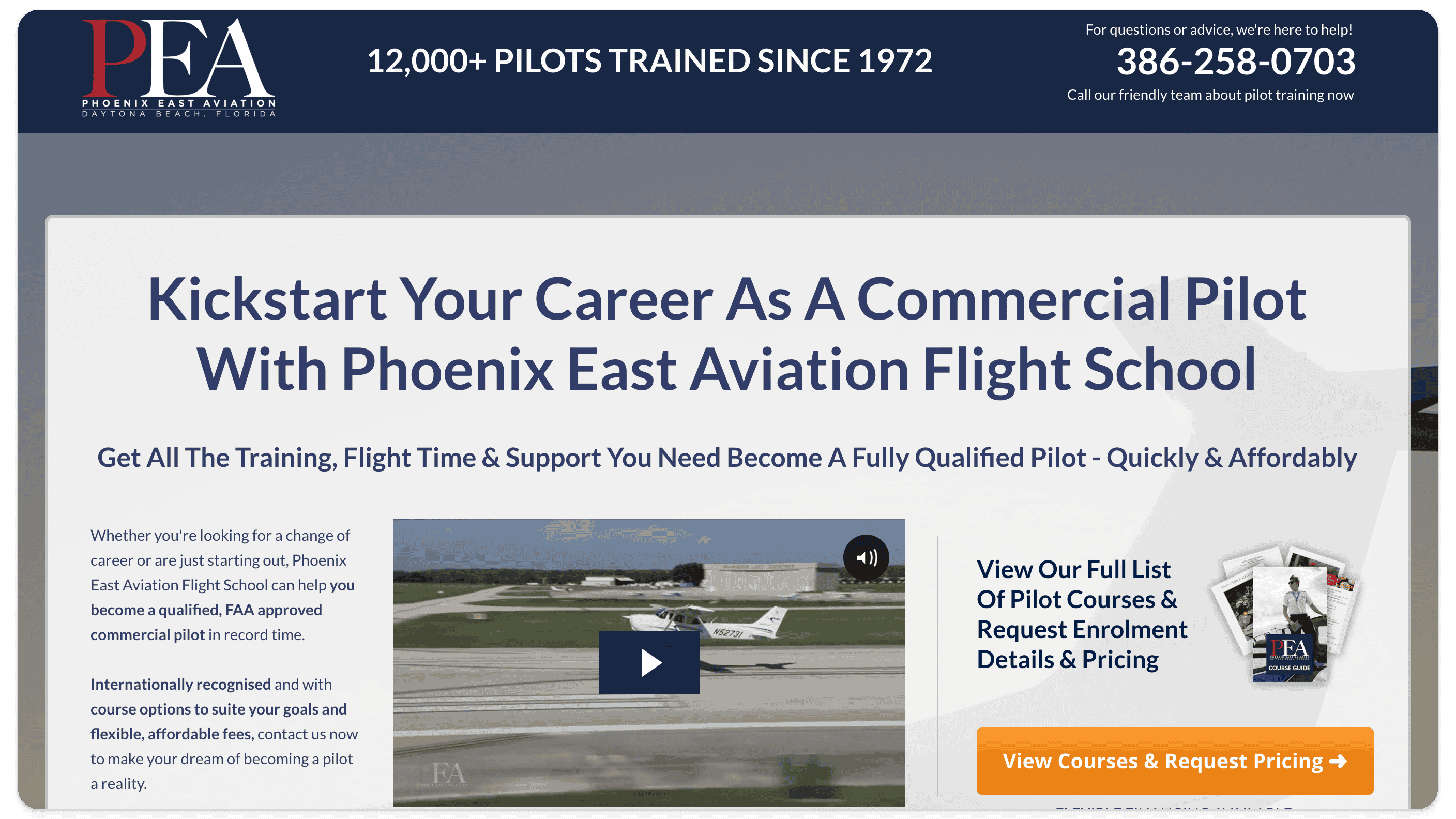
1. Separate Your Landing Page from Your Main Website
One of the most common mistakes businesses make is linking their ads to their homepage, instead of using a dedicated landing page for their ads. While using your homepage might seem convenient, it’s far from optimal. Your homepage is typically cluttered with navigation tabs, multiple calls to action, and a variety of unnecessary distractions that can divert visitors from the primary goal: converting into a lead.
Solution: Create a dedicated landing page that is separate from your main website. This page should be free of navigation links and focused solely on converting ad traffic into leads. By doing this, you maintain full control over the content and design, ensuring that the key factors are optimized for conversion. Bottom line: build landing pages. Your conversion rate will thank you!
2. Make Your Contact Information Easily Accessible
For local service businesses, phone calls are often a primary method of contact. Yet, many businesses hide their phone numbers in the footer of the page or behind a contact link, making it difficult for visitors to reach them.

Solution: Place your phone number prominently at the top of your landing page. This simple change makes it easy for potential customers to contact you, which can help increase conversion rate. Make sure the phone number is clickable on for mobile users to facilitate instant dialing (and ensure there are no broken links).
3. Craft a Compelling Headline
Your headline is the first thing website visitors see when they land on your page. It needs to grab their attention and convey the unique value of your service. Generic headlines that simply state the service offered are not enough. If you want more conversions, you need to craft a compelling headline that tells people what you do and how you’re different.
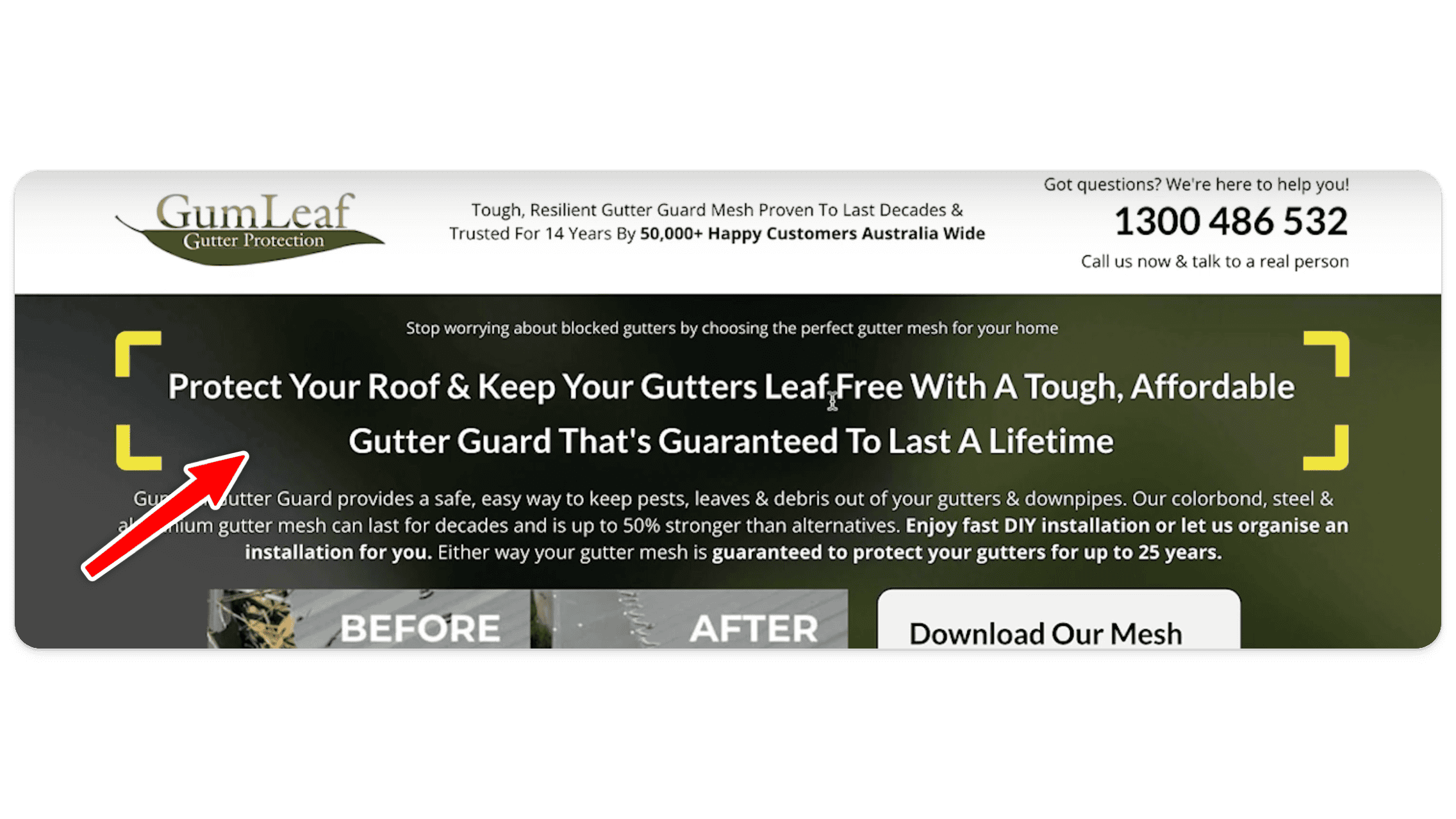
Solution: Create a headline that not only identifies the what the service is, but that also highlights your unique selling points. For example, instead of “We Offer Gutter Mesh Installation,” try “Tough, Affordable Gutter Guard That’s Guaranteed To Last A Lifetime.” This approach immediately differentiates your service from competitors and entices website visitors to read more, and hopefully turn into paying customers.
4. Use a Strong Subheadline to Reinforce the Benefits
After the headline, the subheadline is your next opportunity to engage visitors. This section should reinforce the benefits of your service and address any potential objections a visitor might have.
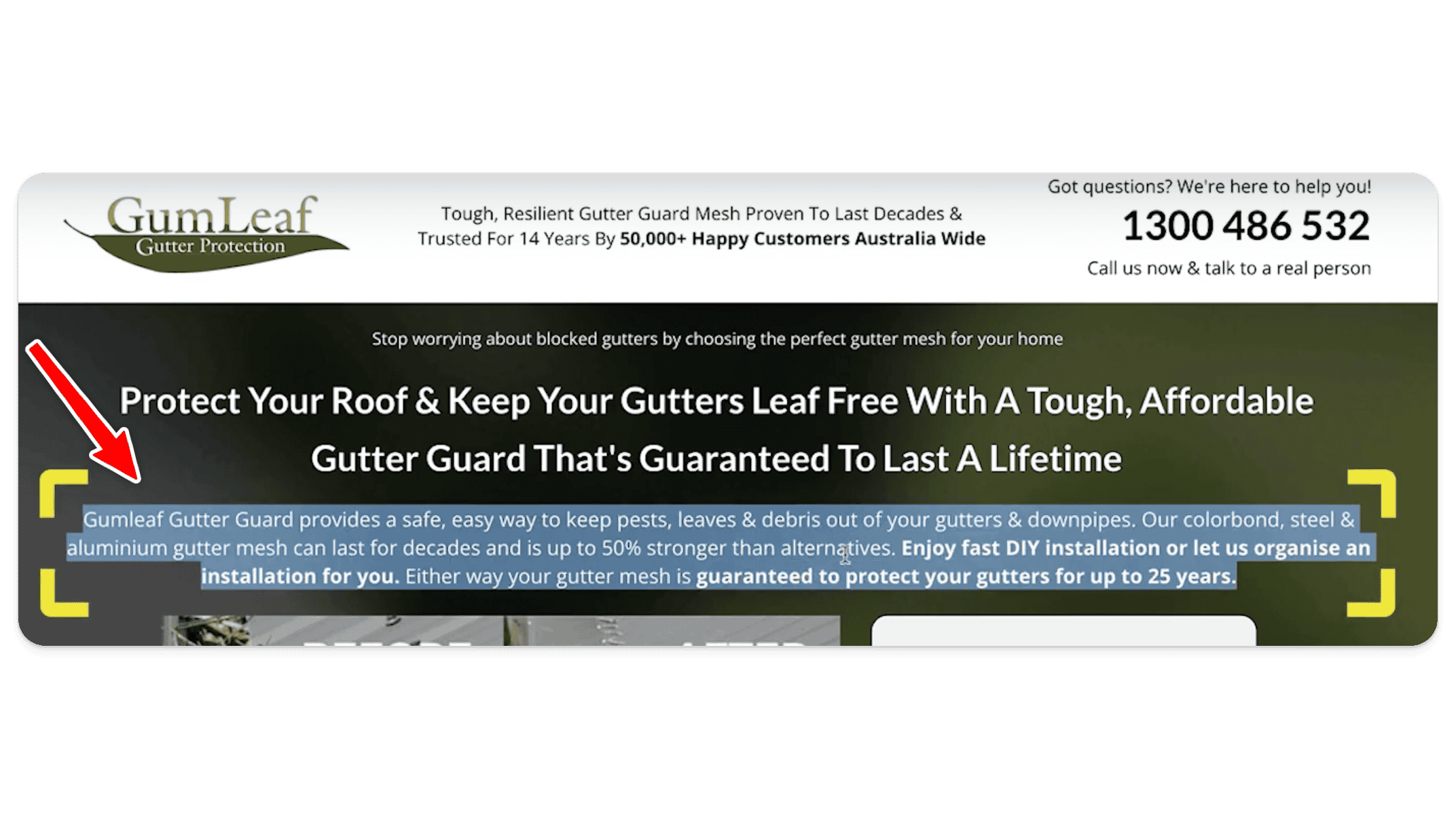
Solution: Your subheadline should be concise yet packed with benefits. The above subheadline tell us the mesh is 50% stronger and guaranteed for 25 years, as well as the fact that the company offers fast installation. This kind of messaging not only reinforces the headline but also provides additional reasons for visitors to choose your service.
5. Optimize Your Call to Action (CTA)
The call-to-action (CTA) is arguably the most critical element on your landing page. A weak or poorly positioned CTA can drastically reduce your conversion rate.
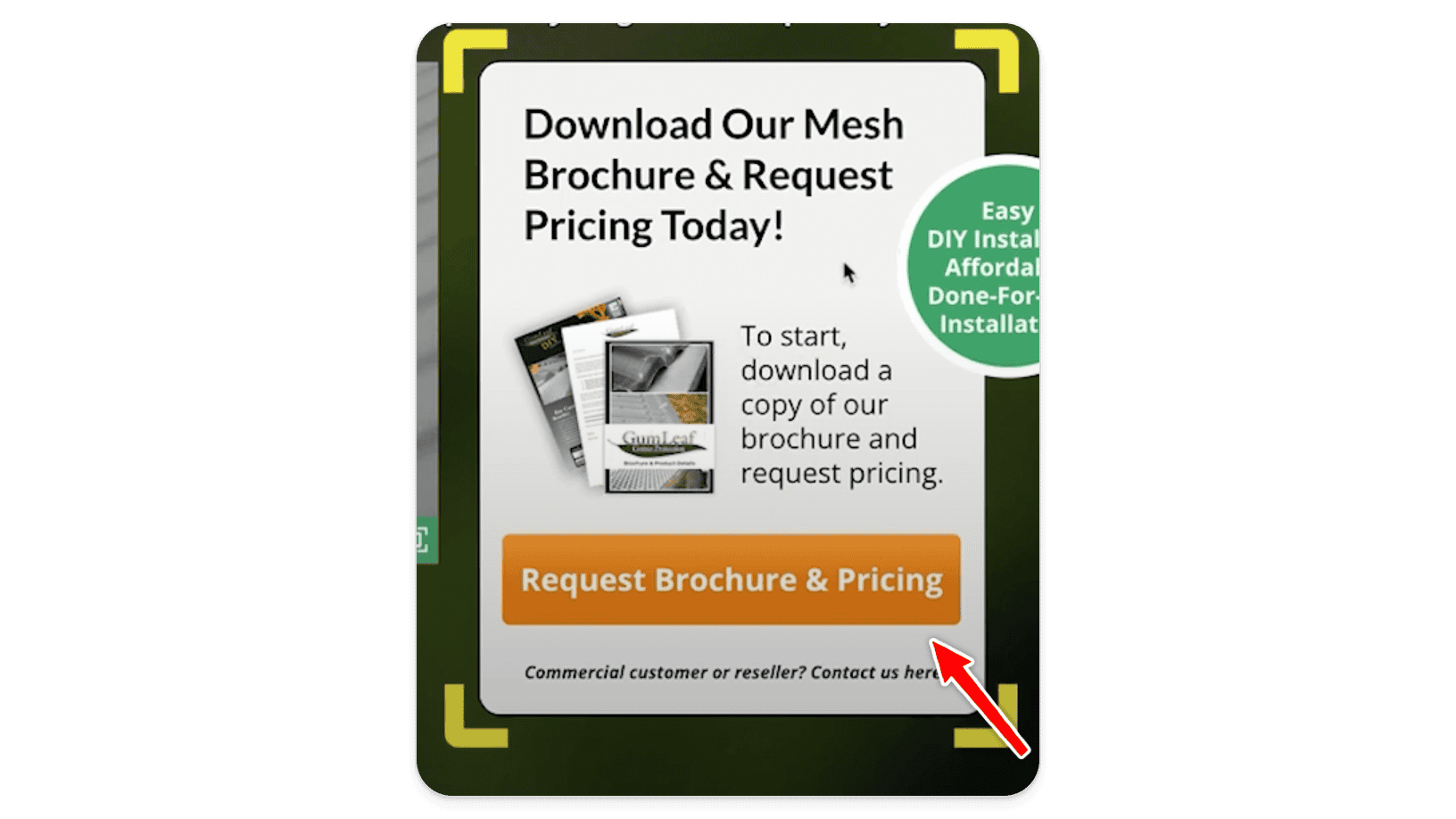
Solution: To increase conversions from web traffic, ensure your CTA is front and center, visually distinct, and compelling. In other words, it should be obvious. Use contrasting colors that draw the eye, and avoid generic CTAs like “Submit,” “Sign up,” or “Contact Us.” Instead, your call to action should offer something of value in exchange for the visitor’s contact information. For example, “Download Our Free Gutter Mesh Guide and Get a Custom Quote” is more enticing to customers than simply asking for their contact details.
6. Offer Something Tangible in Exchange for Contact Information
To improve your website’s conversion rate, offer potential customers something of value in exchange for their information. Visitors are far more likely to provide their contact information if they receive something in return. This concept is known as a lead magnet. A lot of people who land on your page are just gathering information, and are not yet ready to commit. If you can capture a potential customer’s contact details, this will allow you to stay in touch with them so that hopefully later, when they are ready to buy, you are top of mind.
Solution: Offer a downloadable brochure, a free consultation, or a pricing guide in exchange for their contact details. This not only increases the perceived value of your CTA but also helps build trust with your potential customers. The key is to ensure that what you’re offering is relevant and valuable to the visitor.
7. Demonstrate Your Product or Service Effectively
Visual elements can significantly enhance the persuasiveness of your landing page. By demonstrating how your product or service works, you can build trust and credibility with your audience.
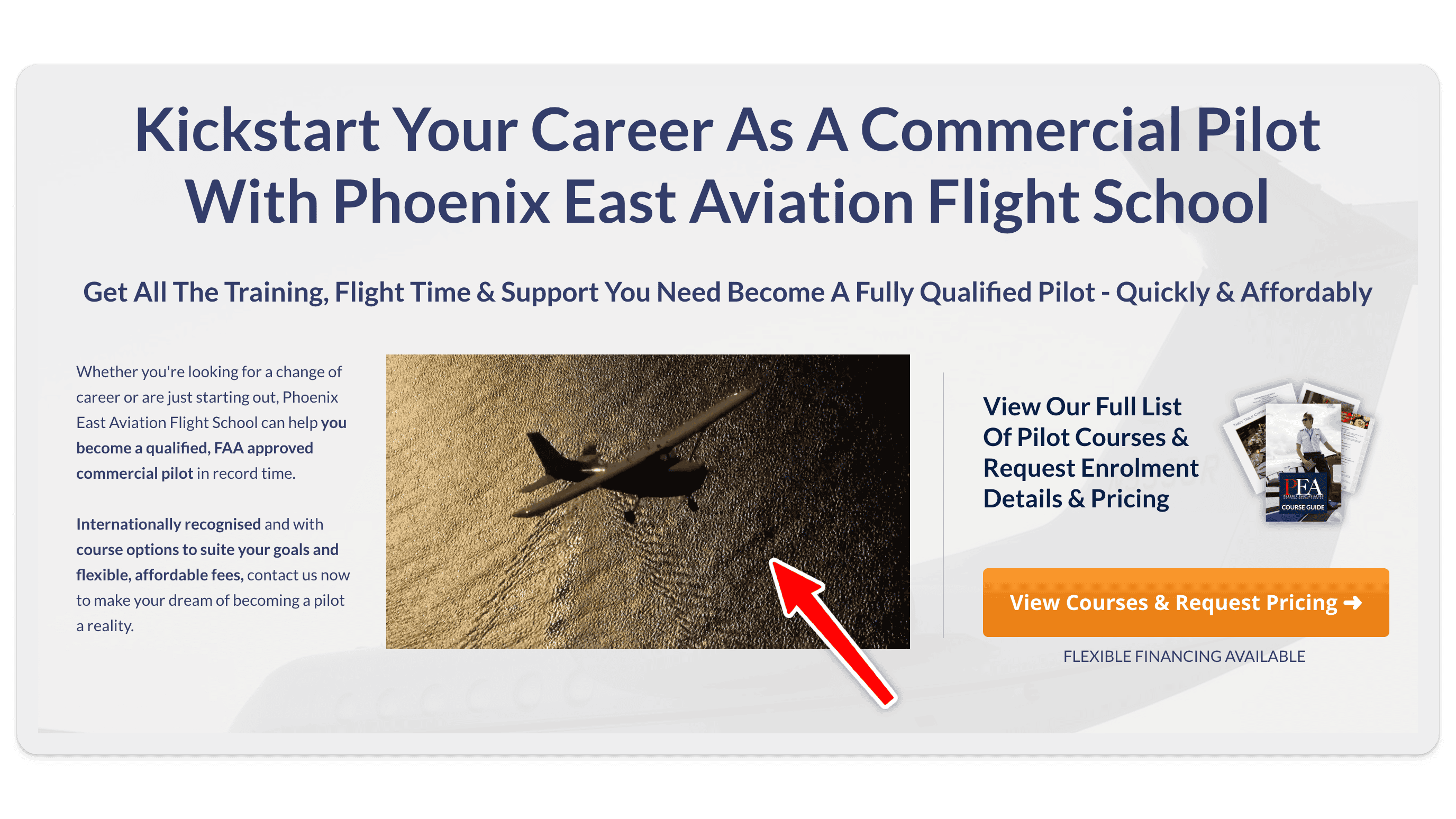
Solution: Include before-and-after images, explanatory videos, or product demos on your landing page. These elements help visitors visualize the benefits of your service (and make them more likely to convert). For example, a short video showing the benefits of learning to fly (and the excitement of flying) can be incredibly persuasive.
8. Incorporate Trust Signals Through Testimonials
Social proof is a powerful tool when it comes to increasing conversions. Potential customers are more likely to trust your business if they see that others have had positive experiences.
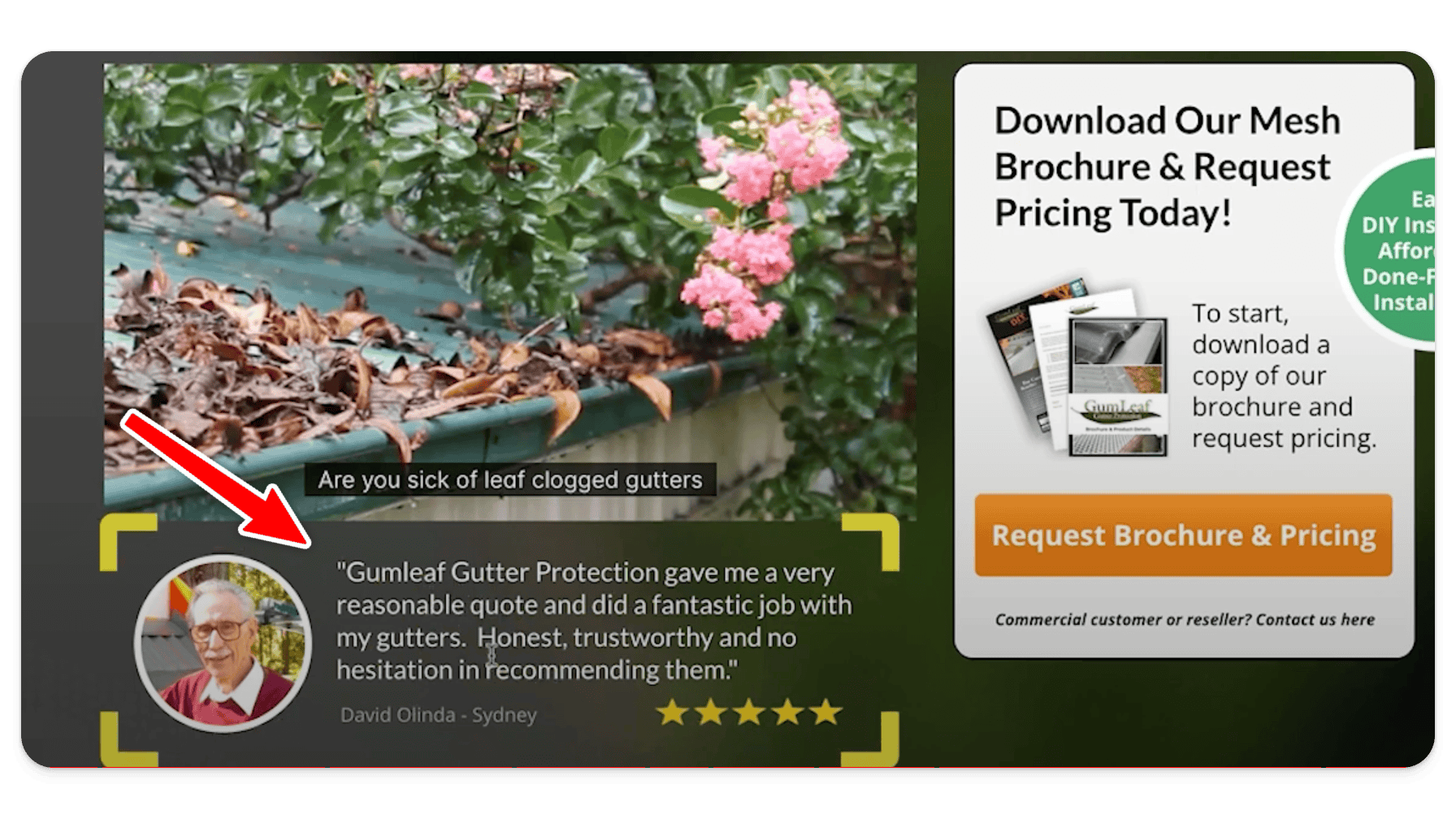
Solution: Place customer feedback prominently on your landing page, ideally above the fold where it is immediately visible (as in the example above). Include the customer’s name, photo, and a brief description of their experience. This adds credibility to the testimonial and makes it more believable, as it’s clear the review is coming from a real person. Additionally, consider adding star ratings or logos from review platforms like Yelp or Google to further enhance trust and increase your conversion rate. You can add more testimonials below the fold as well, as this can help increase conversion rate. Never underrate the power of social proof to improve conversions.
Real-World Examples of High-Converting Landing Pages
To bring these concepts to life, let’s look at a few examples of landing pages that have successfully implemented these strategies to achieve conversion rates of 10% or higher.
1. Catering Service
This landing page follows the principles we’ve discussed to a T. It’s a standalone page, separate from the main website, with no navigation distractions. The phone number is prominently displayed at the top, making it easy for visitors to call.
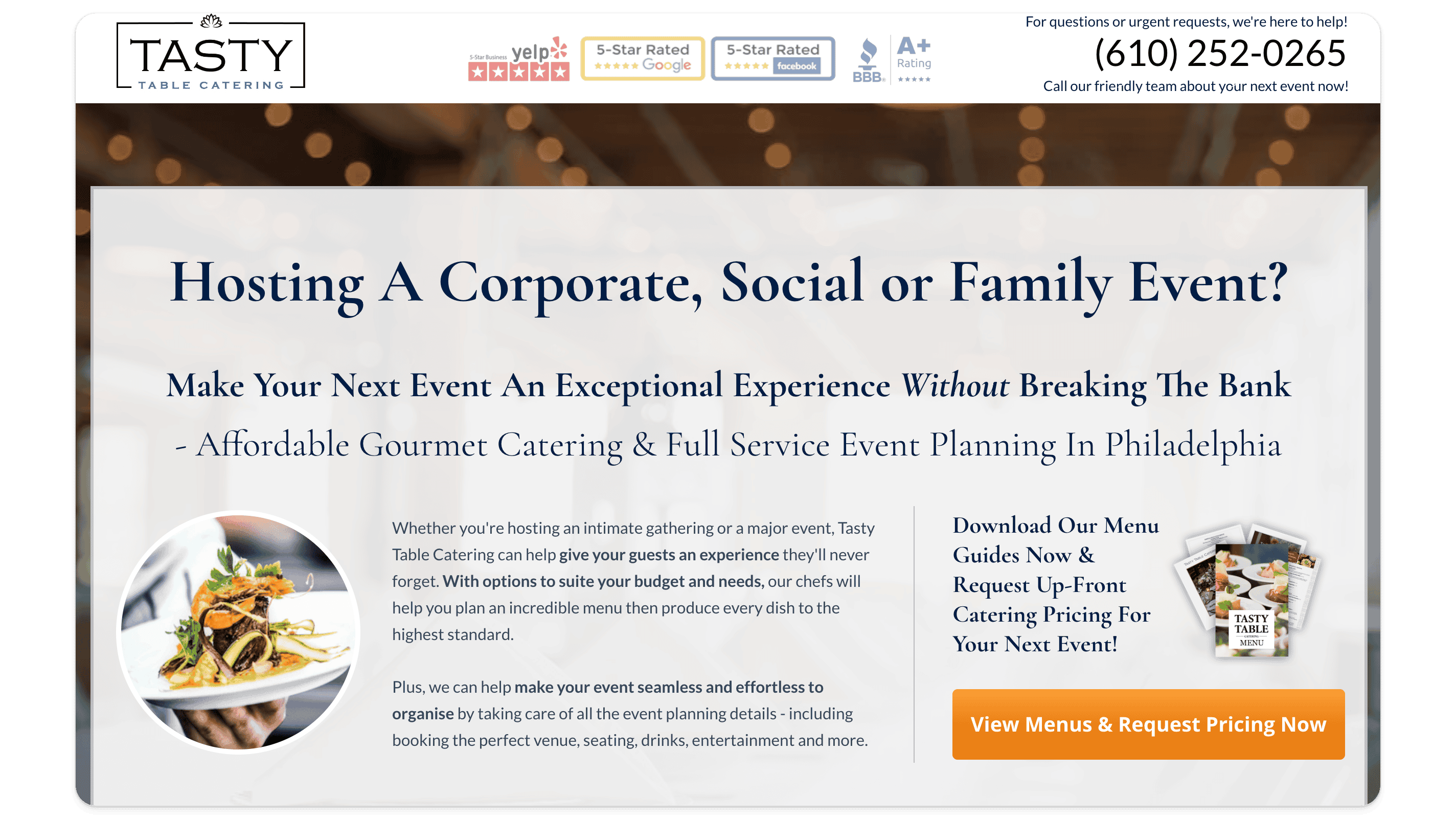
The headline immediately communicates the value proposition, and speaks to the question (or solution) that page visitors are after: “Hosting a Corporate, Social, or Family Event?” Below this, a subheadline reinforces the key benefits: “Affordable Gourmet Catering and Full Service Event Planning in Philadelphia.” Plus, they’ve added a hero image: an eye-catching photo of beautifully plated food, adding to the visual appeal of the page.
Other elements include a CTA, which is clear and compelling: “View Menus and Request Pricing Now.” Visitors are more likely to engage because they’re receiving valuable information in exchange for their contact details.
Note also the customer testimonials with photos and star ratings, which are placed just below the fold, providing social proof that builds trust and adds more credibility to the page.
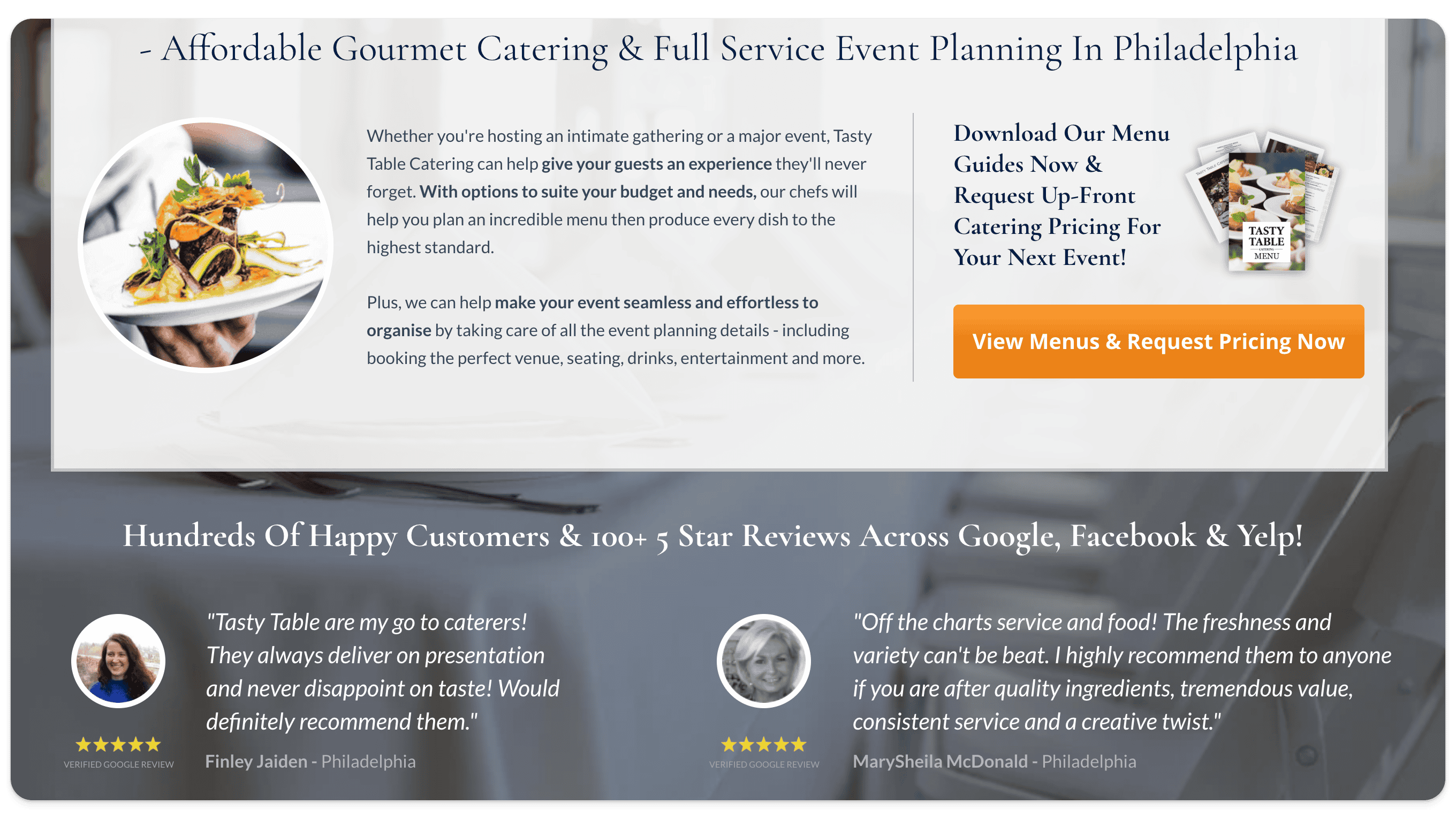
The result is a user-friendly landing page with a clear value proposition that helps the target audience take the next step in the conversion funnel.
2. Sunroom Building Service
This landing page is for a sunroom building service and the whole page follows a similar formula. In fact, this page took this company’s cost per conversion from $500 all the way down to less than $100.
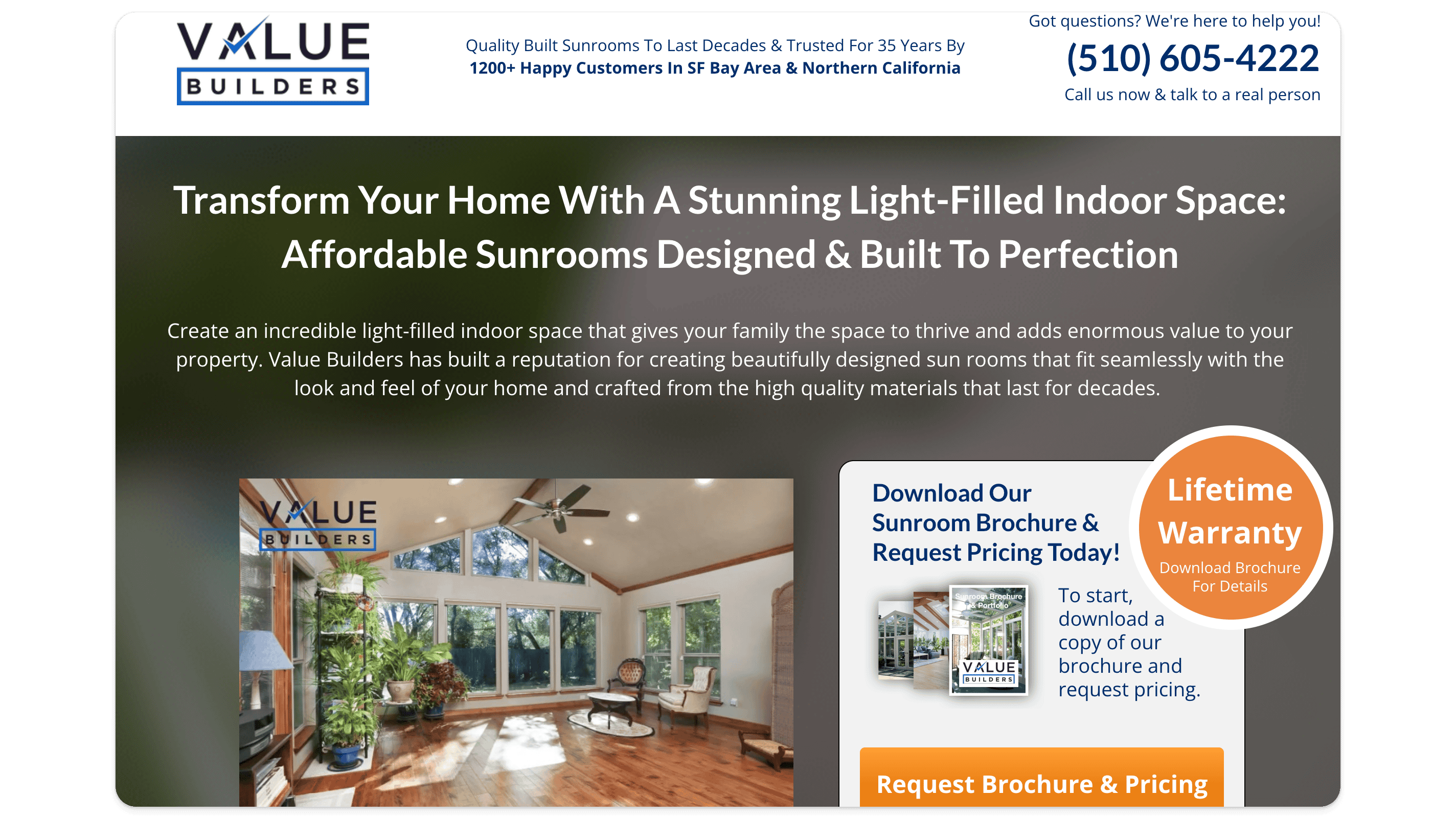
The headline is a powerful statement of their value proposition: “Transform Your Home with a Stunning Light-Filled Indoor Space: Affordable Sunrooms Designed & Built to Perfection.”
The phone number is again prominently placed, ensuring easy access for potential customers (a quick hack for conversion optimization). The call to action, “Request Brochure and Pricing,” is compelling and provides clear value. Plus, the Lifetime Warranty is obvious.
The page includes photos of recent sunroom projects, showcasing the quality of work and the materials used. Customer testimonials with photos and star ratings are displayed just below the fold.
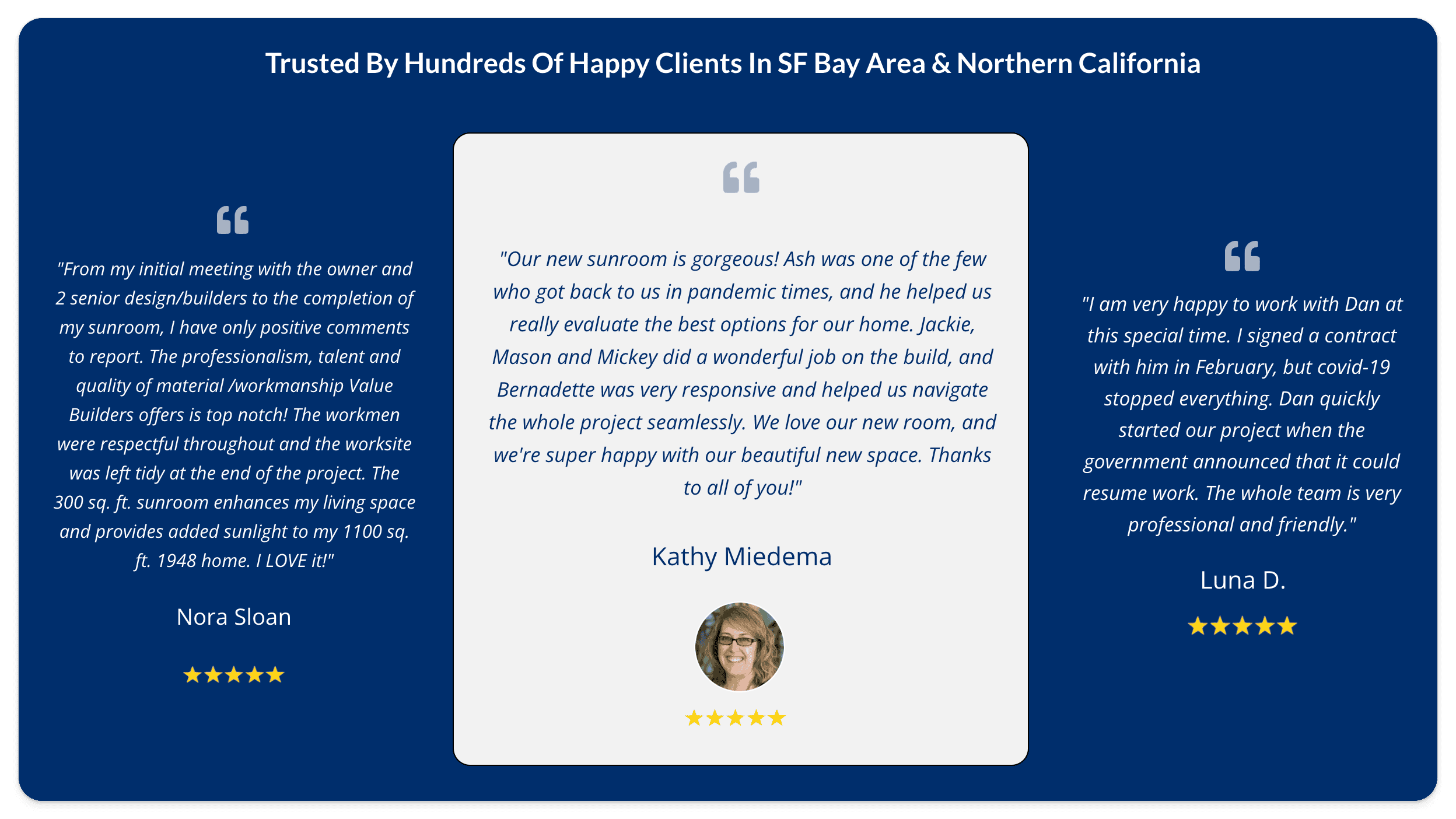
These elements combine to create a high-converting landing page that effectively captures incoming traffic and drives business growth.
Final Thoughts
When it comes to conversion rate optimization, many marketers focus on needle movers in their clients’ Google Ads accounts. That’s great, but it leaves a big piece of the puzzle out of the picture. By implementing the strategies outlined in this guide, you can significantly increase your landing page conversion rates. Remember, the key points of successful conversion rate optimization are:
Understanding your audience
Offering them something valuable
Removing all possible barriers to conversion.
Start by separating your landing page from your main website and eliminating distractions. Make sure your contact information, particularly your phone number, is easy to find. Craft a compelling headline that highlights your unique selling points (and your customers’ pain points, if relevant), and use a strong subheadline to reinforce the benefits.
Optimize your call-to-action (CTA) by making it prominent and offering something tangible in return for visitors’ contact information. Use visual elements like videos and before-and-after images to demonstrate the value of your service. Finally, build trust with testimonials and trust badges.
By following these steps, you’ll not only improve your conversion rate but also enhance the overall effectiveness of your digital marketing campaigns. With a high-converting landing page, you can turn more of your ad traffic into valuable leads and new customers, ensuring the long-term success of your business.
Now it’s your turn. Review your current landing pages, implement these changes, and watch as your conversion rates soar. The strategies we’ve discussed aren’t just theory — they’ve been proven to work for local service businesses, just like yours. Don’t miss out on the opportunity to boost your profitability and grow your business with a fully optimized landing page.



